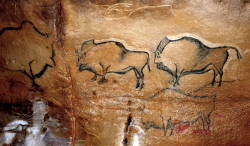Cueva de Covaciella
Useful Information

| Location: |
Alto de las Estazadas, Las Estazadas Gorge.
From Carreña AS-114 to Las Estazadas.
(43.318001, -4.875093) |
| Open: |
closed. [2021] |
| Fee: |
closed. [2021] |
| Classification: |
 Karst Cave Karst Cave
 Painted Cave Painted Cave
|
| Light: | bring torch |
| Dimension: | |
| Guided tours: | closed |
| Photography: | closed |
| Accessibility: | no |
| Bibliography: |
F. J. Fortea Pérez,
M. De La Rasilla Vives,
V. Rodríguez Otero,
M. Hoyos Gómez, F.A.S.E.,
H. Valladas,
T. Torres
(1995):
Covaciella,
Excavaciones Arqueológicas en Asturias 1999-2002. 221-226. Oviedo.
F. J. Fortea Pérez (2007): Cuevas de Covaciella y El Bosque (Cabrales) Campaña de 2000. Excavaciones Arqueológicas en Asturias 1991-1994. 258-270. Oviedo. M. García-Díez, B. Ochoa, J. A. Rodriguez Asensio (eds.) (2015): Arte rupestre paleolítico en la cueva de LaCovaciella (Inguanzo, Asturias) Consejería de Educación, Cultura y deporte, dirección General de Patrimonio Cultural, Oviedo, ISBN: 978-84-7286-455-9. pdf Marcos García-Diez, Blanca Ochoa, Irene Vigiola-Toña, Daniel Garrido, José Adolfo Rodríguez-Asensio (2018): La Cueva De La Covaciella (asturias, España) Excavaciones arqueológicas en Asturias 2013-2016, Consejería de Educación y Cultura, Ediciones Trabe SL, ISBN: 978-84-8053-923-4, ISSN: 1135-7339. pdf |
| Address: | Cueva de Covaciella |
| As far as we know this information was accurate when it was published (see years in brackets), but may have changed since then. Please check rates and details directly with the companies in question if you need more recent info. |
|
History
| OCT-1994 | cave discovered in connection with the roadworks widening the AS-114. |
| 16-OCT-1994 | cave explored by a group of villagers and cave art discovered. |
| 1994 | archaeological research by Javier Fortea, paintings dated with C14 to 14,100±130 BP. |
| 2004 | further archaeologic research. |
| 13-AUG-2008 | inscribed on the UNESCO World Heritage List. |
| 2014 | further archaeologic research. |
Description
The Cueva de Covaciella (Covaciella Cave) is a painted cave which is closed to the public and will never be opened. So if you read about the cave and saw great pictures, forget about seeing the original. However, there are multiple reproductions of high quality you may see.
The cave is located on the left bank of a narrow gorge, cut by a tributary to the River Cares. It begins in a large chamber, which is divided into two parts by a large talus cone. Towards the west a high level passage with a length of 40 m follows. The modern entrance is not the prehistoric entrance, which was probably located at the end of the eastern chamber and became blocked by rockfall. The cave was rediscovered in connection with the roadworks widening the AS-114 in 1994. It was explored by a group of villager who discovered the paintings, the archaeological research by Javier Fortea started immediately. He was able to date the paintings with C14 to 14,100±130 BP.
La Covaciella has only a small number of figures located on the southern wall of the passage. But there are engravings, paintings and combined depictions. The main panel is organised around a large vertical fissure, animals on the left face towards the west and those located on the right - except one - are oriented towards the east. This results in an impression of confrontation. The animals depict stag, horse, ibex and bison. Three outstanding complete figures of bison appear to represent a courtship scene. They are called Los Bisontes (the bisons).
One part called panel de los signos (sign panel) consists of a faded red stain, which is thought to be the remains of a complex sign. The opposite wall is almost completely devoid of pictures, there is only a single red line. The pictures are from the Magdalenian, with parallels in other caves in Northern Spain and the Pyrenees.
- See Replica at
 Parque de la Prehistoria Teverga
Parque de la Prehistoria Teverga
- See also
 Subterranean World Heritage List
Subterranean World Heritage List Search DuckDuckGo for "Cueva de Covaciella"
Search DuckDuckGo for "Cueva de Covaciella" Google Earth Placemark
Google Earth Placemark La Covaciella Cave - Wikipedia (visited: 07-JUN-2021)
La Covaciella Cave - Wikipedia (visited: 07-JUN-2021) Covaciella Cave (visited: 07-JUN-2021)
Covaciella Cave (visited: 07-JUN-2021) La Covaciella Cave (visited: 08-JUN-2021)
La Covaciella Cave (visited: 08-JUN-2021) La Covaciella
La Covaciella  (visited: 08-JUN-2021)
(visited: 08-JUN-2021) Reconstrucción 3D de la Covaciella © Excmo. Ayuntamiento de Cabrales (visited: 07-JUN-2021)
Reconstrucción 3D de la Covaciella © Excmo. Ayuntamiento de Cabrales (visited: 07-JUN-2021) Cave of Altamira and Paleolithic Cave Art of Northern Spain (visited: 26-APR-2020)
Cave of Altamira and Paleolithic Cave Art of Northern Spain (visited: 26-APR-2020)
 Index
Index Topics
Topics Hierarchical
Hierarchical Countries
Countries Maps
Maps